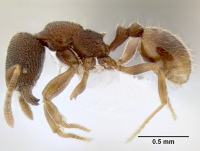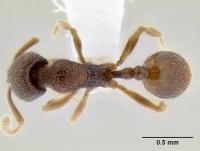Stenamma saenzae
| Stenamma saenzae | |
|---|---|

| |
| Scientific classification | |
| Kingdom: | Animalia |
| Phylum: | Arthropoda |
| Class: | Insecta |
| Order: | Hymenoptera |
| Family: | Formicidae |
| Subfamily: | Myrmicinae |
| Tribe: | Stenammini |
| Genus: | Stenamma |
| Species: | S. saenzae |
| Binomial name | |
| Stenamma saenzae Branstetter, 2013 | |
Stenamma saenzae is known almost exclusively from extracts of sifted leaf litter, with only a few queens collected from flight intercept traps in Belize. It is restricted to montane wet forest environments (e.g. cloud forest, mesophyll forest, pine cloud forest, oak-pine forest, liquidambar-oak-pine forest) and has been collected from 1000–2100 m elevation. Dealate queens as well as workers are commonly collected from leaf litter, suggesting that nests might be located within this stratum.
Identification
Branstetter (2013) - Integument mostly brown to orange-brown and mottled; small-sized species (see HL, ML, PrW below); basal margin of mandible sinuous, always with a basal notch containing a small tooth; anterior clypeal margin undulating, often forming 4 blunt teeth; face completely sculptured, usually mostly rugoreticulate; gastral pilosity with a dense layer of short decumbent to appressed setae, and a sparse layer of longer suberect setae; eye small (EL 0.05–0.09, REL 10–16), subcircular, with 3–5 ommatidia at greatest diameter; posterior extension of clypeus between antennal insertions narrow (PCW 0.01–0.02), with inner margins of frontal lobes almost touching anteriorly; scape short (SI 81–92), not reaching posterior margin of head when laid back; propodeal spines tuberculate to short (PSL 0.07–0.14, PSI 1.5–2.3). Similar species:
Based on overall size and form, S. saenzae might be confused with Stenamma crypticum, Stenamma excisum and Stenamma nanozoi but out of these species, S. nanozoi is the only species to share the small tooth on the basal margin of the mandible. Stenamma saenzae can be easily separated from S. nanozoi by comparing gastral pilosity, which in the latter species, is composed mainly of a sparse layer of thickened suberect setae. Stenamma saenzae shows considerable morphological variability among populations.
Keys including this Species
Distribution
Southern Mexico to Honduras.
Latitudinal Distribution Pattern
Latitudinal Range: 17.276607° to 14.55112°.
| North Temperate |
North Subtropical |
Tropical | South Subtropical |
South Temperate |
- Source: AntMaps
Distribution based on Regional Taxon Lists
Neotropical Region: Belize, Guatemala, Honduras, Mexico (type locality).
Distribution based on AntMaps
Distribution based on AntWeb specimens
Check data from AntWeb
Countries Occupied
| Number of countries occupied by this species based on AntWiki Regional Taxon Lists. In general, fewer countries occupied indicates a narrower range, while more countries indicates a more widespread species. |

|
Estimated Abundance
| Relative abundance based on number of AntMaps records per species (this species within the purple bar). Fewer records (to the left) indicates a less abundant/encountered species while more records (to the right) indicates more abundant/encountered species. |

|
Biology
Castes
Males have not been collected.
Worker
Images from AntWeb
   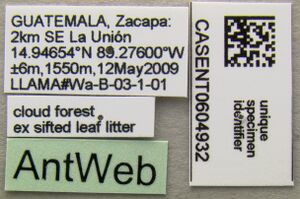
| |
| Worker. Specimen code casent0604932. Photographer Michael Branstetter, uploaded by Default Group. | Owned by MGBPC. |
 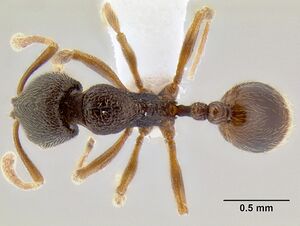  
| |
| Worker. Specimen code casent0620169. Photographer Michael Branstetter, uploaded by Default Group. | Owned by LACM. |
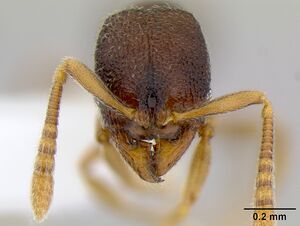 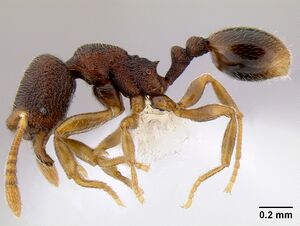  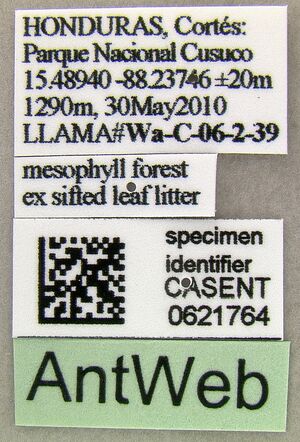
| |
| Worker. Specimen code casent0621764. Photographer Michael Branstetter, uploaded by Default Group. | Owned by MGBPC. |
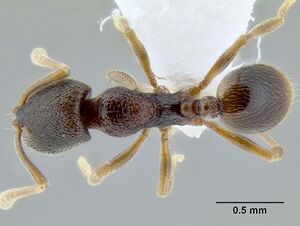  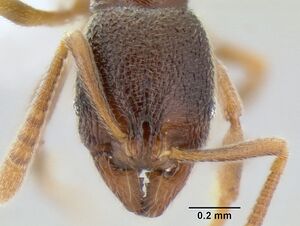 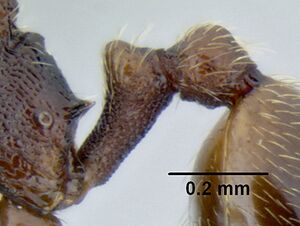 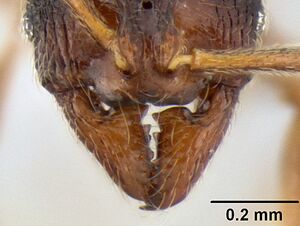  
| |
| Holotype Stenamma saenzae. Worker. Specimen code casent0603860. Photographer Michael Branstetter, uploaded by Default Group. | Owned by MGBPC. |
 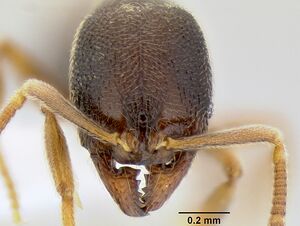    
| |
| Worker. Specimen code casent0604912. Photographer Michael Branstetter, uploaded by Default Group. | Owned by MGBPC. |
Queen
Images from AntWeb
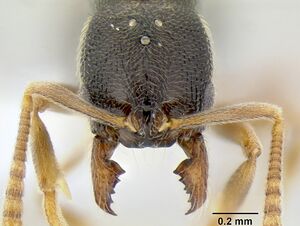  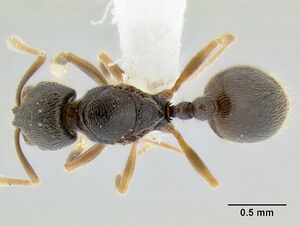 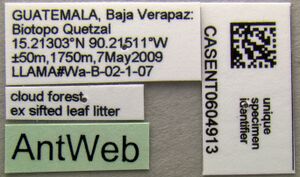
| |
| Worker. Specimen code casent0604913. Photographer Michael Branstetter, uploaded by Default Group. | Owned by MGBPC. |
 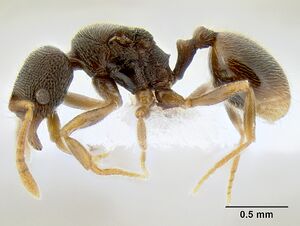  
| |
| Paratype Stenamma saenzae. Queen (alate/dealate). Specimen code casent0603866. Photographer Michael Branstetter, uploaded by Default Group. | Owned by USNM. |
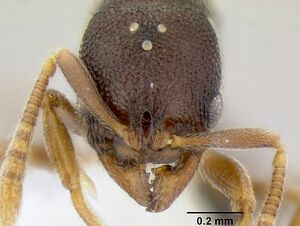   
| |
| Queen (alate/dealate). Specimen code casent0621730. Photographer Michael Branstetter, uploaded by Default Group. | Owned by MGBPC. |
Nomenclature
The following information is derived from Barry Bolton's Online Catalogue of the Ants of the World.
- saenzae. Stenamma saenzae Branstetter, 2013: 225, figs. 146-148 (w.q.) MEXICO (Chiapas), BELIZE, GUATEMALA, HONDURAS.
- Type-material: holotype worker, 15 paratype workers, 3 paratype queens.
- Type-locality: holotype Mexico: Chiapas, 5 km NE Coapilla, 17.17550°N, 93.13212°W, 1990 m., 25.v.2008, LLAMA Wa-A-04-1-26; paratypes: 5 workers, 1 queen with same data but 17.18330°N, 93.15209°W±50m., 1915 m., LLAMA Wa-A-04-2-07, 4 workers with same data but 17.17550°N, 93.13212°W±50m., 1990 m., LLAMA Wa-A-04-2-06, 6 workers, 1 queen with same data but 17.18296°N, 93.15197°W±50m., 1915 m., LLAMA Wa-A-04-2-15, 1 queen with same data but 17.18273°N, 93.15184°W±50m., 1915 m., LLAMA Wa-A-04-2-21.
- Type-depositories: USNM (holotype); CASC, CFSS, EAPZ, FMNH, ICNB, INBC, JTLC, LACM, MCZC, MGBC, MZSP, UCDC, UNAM, USNM, UVGC (paratypes).
- Distribution: Beliza, Guatemala, Honduras, Mexico.
Unless otherwise noted the text for the remainder of this section is reported from the publication that includes the original description.
Description
Worker
(16 measured) HL 0.52–0.69 (0.65), HW 0.43–0.59 (0.54), FLD 0.11–0.14 (0.14), PCW 0.01–0.02 (0.02), SL 0.36–0.50 (0.50), EL 0.05–0.09 (0.07), ACL 0.37–0.49 (0.47), ML 0.60–0.82 (0.77), PrW 0.30–0.41 (0.38), PSL 0.07–0.14 (0.10), SDL 0.04–0.07 (0.06), PL 0.23–0.31 (0.29), PH 0.14–0.18 (0.17), PW 0.11–0.14 (0.14), PPL 0.12–0.19 (0.16), PPH 0.12–0.17 (0.17), PPW 0.14–0.19 (0.17), MFL 0.39–0.53 (0.51), MTL 0.32–0.44 (0.41), CI 84–89 (84), SI 81–92 (92), REL 10–16 (13), FLI 22–27 (26), PSI 1.5–2.3 (1.6), MFI 107–119 (107), ACI1 69–73 (70), ACI2 94–105 (94).
Small-sized species; general body color a mottled dark brown to light orange-brown, with mandibles and appendages lighter, usually orange-brown to yellow-brown; setae golden brown; mandible with 6–7 teeth (usually 6), consisting of 2–3 distinct apical teeth, a distinct, usually well-defined basal tooth, and 2–3 inner teeth, which are sometimes worn and indistinct; basal margin of mandible sinuous and always with a small basal notch containing a tooth; mandible mostly smooth and shining, with scattered piligerous punctae and basal striae; anterior clypeal margin viewed at an anterodorsal angle weakly to strongly undulating (appearing nearly flat in full-face view), often forming 4 blunt teeth, median undulation (emargination) sometimes narrow and notch-like; median lobe of clypeus lacking a distinct pair of longitudinal carinulae, either completely smooth, or with faint irregular striations (type population), apex of lobe with a transverse carina, remainder of clypeus mostly smooth and shiny; posterior extension of clypeus between antennal insertions very narrow (PCW 0.01–0.02), with sides subparallel and inner margins of frontal lobes almost touching anteriorly; frontal lobes of moderate width (FLD 0.11–0.14, FLI 22–27), not obscuring torular lobes in full-face view; head appearing subrectangular (CI 84–89), with posterior margin depressed medially; eyes small (EL 0.05–0.09, REL 10–16), subcircular to slightly oblong, with 3–5 ommatidia at greatest diameter; face densely sculptured, usually mostly rugoreticulate, with longitudinal rugae medially, but sometimes reticulae less distinct and interconnected, interstices lightly punctate; scape relatively short, not reashing posterior margin of head when laid back (SI 81–92), usually of average thickness (type population), but some populations with scape distinctly swollen distally; scape cuticle mostly smooth and somewhat shiny, with scattered piligerous punctae; flagellum with somewhat distinct 4-segmented antennal club, apical segment noticeably enlarged; sculpture on mesosoma variable among populations, lateral surface usually weakly to strongly punctate, with variable number of longitudinal rugulae, dorsal surface of promesonotum variably rugulose-punctate, with pronotum ranging from completely smooth to strongly sculptured, most populations intermediate (type population), pronotum sometimes with a distinct longitudinal carina; propodeal declivity smooth and shiny or with a few transverse carinulae; promesonotum in profile low-domed and roughly symmetrical (type population), or less often flattened and more asymmetrical, with anterior face distinctly longer than posterior; propodeal spines tuberculate or forming short, broad triangular spines (PSL 0.07–0.14, PSI 1.5–2.3); metanotal grove usually well demarcated, of moderate depth and width; petiole of moderate length (PL/HW 0.47–0.56), average-looking; node in profile somewhat small (PH/PL 0.57– 0.64), subconical, with anterior face slightly longer and more sloping than posterior face, node dorsum in profile rounded, pointing vertical to slightly posteriad; postpetiole in profile subcircular, usually appearing similar in size to petiolar node (type population), but sometimes slightly larger and more bulging (PPH/PH 0.86–1.08); petiole and postpetiole lightly to somewhat strongly punctate, with nodes variably smooth and shiny; gaster mostly smooth and shiny, with scattered piligerous punctae; most of body dorsum with very short suberect to decumbent pilosity; scapes with a dense layer of decumbent to appressed setae; gastral pilosity consisting of a dense decumbent (type population) to appressed layer of setae, and a much sparser layer of suberect se-tae, which is sometimes difficult to see among decumbent setae; setae on legs mostly appressed, with a few suberect setae on coxae and femoral venters.
Queen
(5 measured) HL 0.56–0.67 (0.66), HW 0.50–0.59 (0.59), FLD 0.12–0.15 (0.15), PCW 0.02–0.03 (0.03), SL 0.41–0.51 (0.51), EL 0.13–0.15 (0.15), ACL 0.41–0.51 (0.51), ML 0.77–0.92 (0.91), PrW 0.43–0.52 (0.52), PSL 0.10–0.11 (0.10), SDL 0.06–0.08 (0.07), PL 0.27–0.32 (0.32), PH 0.16–0.19 (0.19), PW 0.14–0.16 (0.16), PPL 0.15–0.19 (0.19), PPH 0.16–0.19 (0.19), PPW 0.17–0.21 (0.21), MFL 0.44–0.55 (0.54), MTL 0.37–0.46 (0.46), CI 84–91 (89), SI 80–90 (86), REL 25–26 (26), FLI 24–27 (25), PSI 1.3–1.8 (1.5), MFI 103–115 (108), ACI1 69–72 (69), ACI2 95–100 (100).
Same as worker except for standard queen modifications and as follows: pronotum transversely rugose to rugoreticulate laterad, becoming punctate mesad; mesoscutum with narrow strip of smooth cuticle extending from anterior margin to about midpoint along midline; mesopleuron mostly smooth and shiny; propodeum mostly with transverse carinulae that wrap around surface, or less often mostly punctate; propodeal spines smaller (PSL 0.10–0.11, PSI 1.3–1.8).
Type Material
Holotype worker. MÉXICO, Chiapas: 5km NE Coapilla, 17.17550°N, 93.13212°W, 1990m, 25 May 2008, 2° mesophyll forest, ex sifted leaf litter (LLAMA, collection Wa-A-04-1-26) USNM, specimen CASENT0603860]. Paratypes: same data as holotype but 17.18330°N, 93.15209°W ±50m, 1915m, 25 May 2008 (LLAMA, Wa-A-04-2-07) 1dq, 1w, CASC, CASENT0623473, CASENT0623474, 1w, EAPZ, CASENT0623475, 1w, ECOSCE, CASENT0623476, 1w, FMNH, CASENT0623477, 1w, ICN, CASENT0623478]; 17.17550°N, 93.13212°W ±50m, 1990m, 25 May 2008 (LLAMA, Wa-A-04-2-06) 1w, INBC, CASENT0623469, 1w, JTLC, CASENT0623470, 1w, LACM, CASENT0623471, 1w, MGBPC, CASENT0623472]; 17.18296°N, 93.15197°W ±50m, 1915m, 25 May 2008 (LLAMA, Wa-A-04-2-15) 1dq, 1w, MCZ, CASENT0623479, CASENT0623480, 1w, MZSP, CASENT0623481, 1w, UCDC, CASENT0623482, 1w, UNAM, CASENT0623483, 1w, UVGC, CASENT0623484, 1w, USNM, CASENT0623485]; 17.18273°N, 93.15184°W ±50m, 1915m, 25 May 2008 (LLAMA, Wa-A-04-2-21) 1dq, USNM, CASENT0603866
References
- Branstetter, M. G. 2012. Origin and diversification of the cryptic ant genus Stenamma Westwood (Hymenoptera: Formicidae), inferred from multilocus molecular data, biogeography and natural history. Systematic Entomology 37:478-496. doi:10.1111/j.1365-3113.2012.00624.x
- Branstetter, M.G. 2013. Revision of the Middle American clade of the ant genus Stenamma Westwood (Hymenoptera, Formicidae, Myrmicinae). ZooKeys 295, 1–277. doi:10.3897/zookeys.295.4905
References based on Global Ant Biodiversity Informatics
- Branstetter M.G. 2013. Revision of the Middle American clade of the ant genus Stenamma Westwood (Hymenoptera, Formicidae, Myrmicinae). ZooKeys 295: 1277
- Dattilo W. et al. 2019. MEXICO ANTS: incidence and abundance along the Nearctic-Neotropical interface. Ecology https://doi.org/10.1002/ecy.2944
- Longino J. T. L., and M. G. Branstetter. 2018. The truncated bell: an enigmatic but pervasive elevational diversity pattern in Middle American ants. Ecography 41: 1-12.
